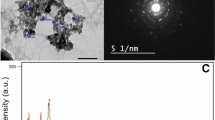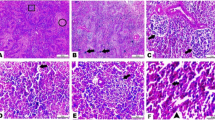Abstract
Broilers in four groups were fed a basal diet supplemented with 60 mg/kg zinc oxide (60-ZnO; control), or 20, 60, or 100 mg/kg ZnO nanoparticles (20-, 60-, and 100-nano-ZnO, respectively). Compared with the controls, after 14 days, birds in the 20- and 60-nano-ZnO groups had significantly greater weight gains and better feed conversion ratios. However, the body weight of birds in the 100-nano-ZnO group was dramatically reduced after 28 days. Relative to the control group, the total antioxidant capability (T-AOC) in serum and liver tissue was significantly higher in the 20-nano-ZnO group at all time points and also significantly higher in the 60- and 100-nano-ZnO groups in serum on days 28 and 35 and in liver tissues on days 21 and 28. Compared with the controls, the activity of copper-zinc superoxide dismutase (Cu-Zn-SOD) was significantly greater in the 60- and 100-nano-ZnO groups in serum on days 28 and 35 and in liver tissues after 21 days. Catalase activity in serum samples was significantly higher in the 20- and 60-nano-ZnO groups relative to the control and 100-nano-ZnO birds, but catalase activity in liver tissue was not affected by different nano-ZnO levels. Malondialdehyde content in serum and liver tissues was significantly reduced in the 20-, 60-, and 100-nano-ZnO groups compared with that in the control group at all time points except day 42. Taken together, our data indicate that appropriate concentration of dietary ZnO nanoparticles improves growth performance and antioxidative capabilities in broilers, and 20 mg/kg nano-ZnO is the optimal concentration.
Similar content being viewed by others

References
Liu ZH, Lu L, Li SF, Zhang LY, Xi L, Zhang KY, Luo XG (2011) Effects of supplemental zinc source and level on growth performance, carcass traits, and meat quality of broilers. Poult Sci 90(8):1782–1790
Feng J, Ma WQ, Niu HH, Wu XM, Wang Y, Feng J (2010) Effects of zinc glycine chelate on growth, hematological, and immunological characteristics in broilers. Biol Trace Elem Res 133(2):203–211
Kietzmann M, Braun M (2006) Effects of the zinc oxide and cod liver oil containing ointment Zincojecol in an animal model of wound healing. Dtsch Tierarztl Wochenschr 113(9):331–334
Nitrayova S, Windisch W, von Heimendahl E, Muller A, Bartelt J (2012) Bioavailability of zinc from different sources in pigs. J Anim Sci 90(Suppl 4):185–187
Baiarzhal M, Zilova IS, Gmoshinskii IV, Buchanova AV, Sheviakova LV, Makhova NN, Mazo VK (2008) Comparative evaluation of zinc organic and inorganic form bioavailability in vivo. Vopr Pitan 77(1):34–37
Schlegel P, Sauvant D, Jondreville C (2013) Bioavailability of zinc sources and their interaction with phytates in broilers and piglets. Animal 7(1):47–59
Bratz K, Golz G, Riedel C, Janczyk P, Nockler K, Alter T (2013) Inhibitory effect of high-dosage zinc oxide dietary supplementation on Campylobacter coli excretion in weaned piglets. J Appl Microbiol 115(5):1194–1202
Broom LJ, Miller HM, Kerr KG, Toplis P (2003) Removal of both zinc oxide and avilamycin from the post-weaning piglet diet: consequences for performance through to slaughter. Anim Sci 77:79–84
Poulsen HD (1995) Zinc oxide for weanling piglets. Acta Agric Scand A-Anim Sci 45(3):159–167
Sundaresan NR, Anish D, Sastry KV, Saxena VK, Nagarajan K, Subramani J, Leo MD, Shit N, Mohan J, Saxena M, Ahmed KA (2008) High doses of dietary zinc induce cytokines, chemokines, and apoptosis in reproductive tissues during regression. Cell Tissue Res 332(3):543–554
Case CL, Carlson MS (2002) Effect of feeding organic and inorganic sources of additional zinc on growth performance and zinc balance in nursery pigs. J Anim Sci 80(7):1917–1924
Scott NR (2005) Nanotechnology and animal health. Rev Sci Tech 24(1):425–432
Scheerlinck JP, Gloster S, Gamvrellis A, Mottram PL, Plebanski M (2006) Systemic immune responses in sheep, induced by a novel nano-bead adjuvant. Vaccine 24(8):1124–1131
Tan MJ, Zhong S, Li J, Chen Z, Chen W (2013) Air-stable efficient inverted polymer solar cells using solution-processed nanocrystalline ZnO interfacial layer. ACS Appl Mater Interfaces 5(11):4696–4701
Tsuzuki T, He R, Wang J, Sun L, Wang X (2012) Reduction of the photocatalytic activity of ZnO nanoparticles for UV protection applications. Int J Nanotechnol 9(10-12SI):1017–1029
Sinha R, Kim GJ, Nie S, Shin DM (2006) Nanotechnology in cancer therapeutics: bioconjugated nanoparticles for drug delivery. Mol Cancer Ther 5(8):1909–1917
Lucas JM (2010) Microarrays: Molecular allergology and nanotechnology for personalised medicine (II). Allergol Immunopathol (Madr) 38(4):217–223
Brooks MA, Grimes JL, Lloyd KE, Verissimo S, Speers JW (2013) Bioavailability in chicks of zinc from zinc propionate. J Appl Poult Res 22(2):153–159
Sahraei M, Janmmohamadi H, Taghizadeh A (2013) Estimation of the relative bioavailability of several zinc sources for broilers fed a conventional corn-soybean meal diet. J Poult Sci 50(1):53–59
Petrovic V, Nollet L, Kovac G (2010) Effect of dietary supplementation of trace elements on the growth performance and their distribution in the breast and thigh muscles depending on the age of broiler chickens. Acta Vet Brno 79(2):203–209
Gajula SS, Chelasani VK, Panda AK, Mantena VL, Savaram RR (2011) Effect of supplemental inorganic Zn and Mn and their interactions on the performance of broiler chicken, mineral bioavailability, and immune response. Biol Trace Elem Res 139(2):177–187
Gheisari AA, Sanei A, Samie A, Gheisari MM, Toghyani M (2011) Effect of diets supplemented with different levels of manganese, zinc, and copper from their organic or inorganic sources on egg production and quality characteristics in laying hens. Biol Trace Elem Res 142(3):557–571
Powell SR (2000) The antioxidant properties of zinc. J Nutr 130(5S Suppl):1447S–1454S
Cunningham-Rundles S, Bockman RS, Lin A, Giardina PV, Hilgartner MW, Caldwell-Brown D, Carter DM (1990) Physiological and pharmacological effects of zinc on immune response. Ann N Y Acad Sci 587:113–122
Prasad AS (2008) Clinical, immunological, anti-inflammatory and antioxidant roles of zinc. Exp Gerontol 43(5):370–377
Ozturk O, Gumuslu S (2004) Changes in glucose-6-phosphate dehydrogenase, copper, zinc-superoxide dismutase and catalase activities, glutathione and its metabolizing enzymes, and lipid peroxidation in rat erythrocytes with age. Exp Gerontol 39(2):211–216
Balevska PS, Russanov EM, Kassabova TA (1981) Studies on lipid peroxidation in rat liver by copper deficiency. Int J Biochem 13(4):489–493
Fridovich I (1995) Superoxide radical and superoxide dismutases. Annu Rev Biochem 64:97–112
Jiang Z, Lin Y, Zhou G, Luo L, Jiang S, Chen F (2009) Effects of dietary selenomethionine supplementation on growth performance, meat quality and antioxidant property in yellow broilers. J Agric Food Chem 57(20):9769–9772
Devasena T, Lalitha S, Padma K (2001) Lipid peroxidation, osmotic fragility and antioxidant status in children with acute post-streptococcal glomerulonephritis. Clin Chim Acta 308(1–2):155–161
Sinzato YK, Lima PH, Campos KE, Kiss AC, Rudge MV, Damasceno DC (2009) Neonatally-induced diabetes: lipid profile outcomes and oxidative stress status in adult rats. Rev Assoc Med Bras 55(4):384–388
Duzguner V, Kaya S (2007) Effect of zinc on the lipid peroxidation and the antioxidant defense systems of the alloxan-induced diabetic rabbits. Free Radic Biol Med 42(10):1481–1486
Nielsen F, Mikkelsen BB, Nielsen JB, Andersen HR, Grandjean P (1997) Plasma malondialdehyde as biomarker for oxidative stress: reference interval and effects of life-style factors. Clin Chem 43(7):1209–1214
Acknowledgments
We thank Medjaden Bioscience Limited for assisting in the preparation of this manuscript.
Author information
Authors and Affiliations
Corresponding author
Additional information
Cui-Yan Zhao, Shu-Xian Tan, Xi-Yu Xiao, and Xian-Shuai Qiu contributed equally to this work.
Electronic supplementary material
Below is the link to the electronic supplementary material.
ESM 1
(DOC 36 kb)
Rights and permissions
About this article
Cite this article
Zhao, CY., Tan, SX., Xiao, XY. et al. Effects of Dietary Zinc Oxide Nanoparticles on Growth Performance and Antioxidative Status in Broilers. Biol Trace Elem Res 160, 361–367 (2014). https://doi.org/10.1007/s12011-014-0052-2
Received:
Accepted:
Published:
Issue Date:
DOI: https://doi.org/10.1007/s12011-014-0052-2



